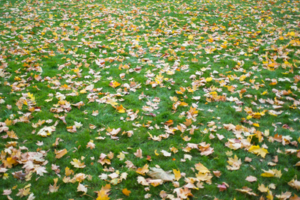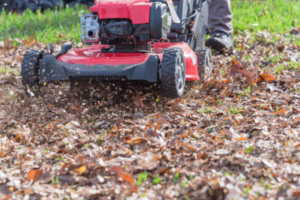It’s that time of year when temperatures plunge, fall explodes in vibrant color, and leaves are everywhere. Do you rake them up and dispose of them? Or should you mulch them into your lawn for the winter?
One of the experts we turned to for advice on this question is John Sorochan, Ph.D. Distinguished Professor of Turfgrass Science at the University of Tennessee in Knoxville. He says your decision should be a no-brainer: put the rake down and turn those leaves into mulch.
Here is a transcript of our interview:
 Q: You recommendation is cut up leaves vs. raking them?
Q: You recommendation is cut up leaves vs. raking them?
Sorochan: Yes. You can have the leaves stacked eight inches deep and mulch them in; you might have to go over it twice with the mulcher to get it in, break it down, chop it up, but as long as it gets it into the canopy that’s the best thing you could be doing for your lawn.
What does the cut-up leaf actually do for the lawn?
It returns nutrients back to the grass. It adds valuable organic matter to make a healthier soil. Microbes like to feed on organic matter as it’s breaking down, but the bigger thing is releasing the nutrients back.
Also, you don’t have to dispose of the leaves, so it makes cleanup and things like that a lot easier.
And then there’s the Michigan State University study that showed that mulched leaves help control dandelions and plantains — broadleaf weeds — from encroaching, from germinating.
You mentioned the canopy. For those who don’t know the term, explain what that is.
You’ve got your lawn and you mow it. Let’s say you’ve got a Tall Fescue lawn and you mowed it three inches. That 0-3 inches is your turf grass canopy where the grass and the leaves are. So as long as you can mulch the leaves so they break up and get down into the canopy — from the top of the grass down by the soil surface is the key.
You want at least half of the grass still being exposed after you mulch the leaves.
 So that raises a question about size of those cut-up pieces. Does size matter?
So that raises a question about size of those cut-up pieces. Does size matter?
If you’ve got a good mulching blade on a mower, that should chop it up, mulch, break down or grind it up, whatever you want to call it. The smaller you can chop, the better. Chop up the leaves sufficiently so that it gets into the canopy. You don’t want those big leaves standing and smothering the surface of the grass.
And it doesn’t matter what lawnmower I’m using to do the job? The goal is to turn the leaves into mulch…
You want to cut it up. The best lawnmowers to use for this are the ones that have the actual mulching blades that kind of suck it up and just return the clippings down so it doesn’t shoot it out the side or the back or something. It’s just going straight down.
Stating the obvious: there’s no benefit to leaving the leaves on the grass all winter, right? Is there ever a consideration where you’d want to neither rake nor mulch?
Not that I know of. I mean, if you do that the leaves are going to sit on top of your grass and it’s going to block the light to your grass. Mold and fungus can grow on it and it’ll kill the grass underneath because it’ll smother it if it’s deep enough. So no, you don’t want to just leave the leaves on the grass.
The big takeaway is that there really shouldn’t be a debate over raking vs. mulching.
There should not be a debate, no. In a home lawn situation the best thing you can do is mulch leaves into your grass. It’s going to be healthy for your lawn.
Now, people who have a zoysia grass lawn or a Bermuda grass lawn and it’s going dormant this time of year, it’s all brown — it may be difficult in some of these zoysia grass lawns, because they are so dense, it might not be as easy to get the leaf mulch down and broken down. That would be the only challenge that I could see.
But even then you just run over it a second time until the leaf pieces get into the canopy.
Or even a third time, yeah.
Even with just mowing your lawn, you should always return the grass clippings, never remove them.

